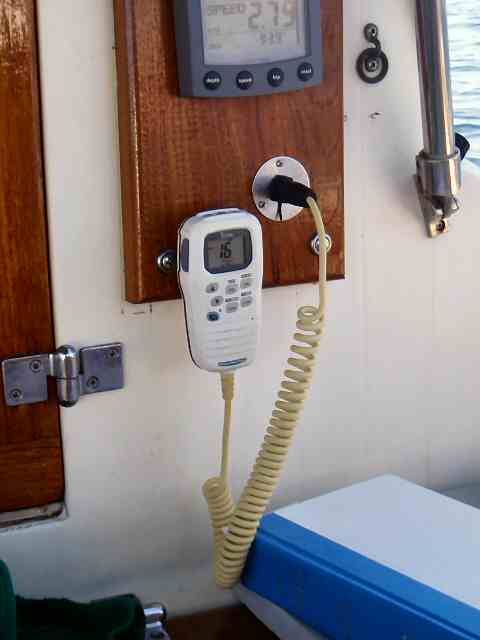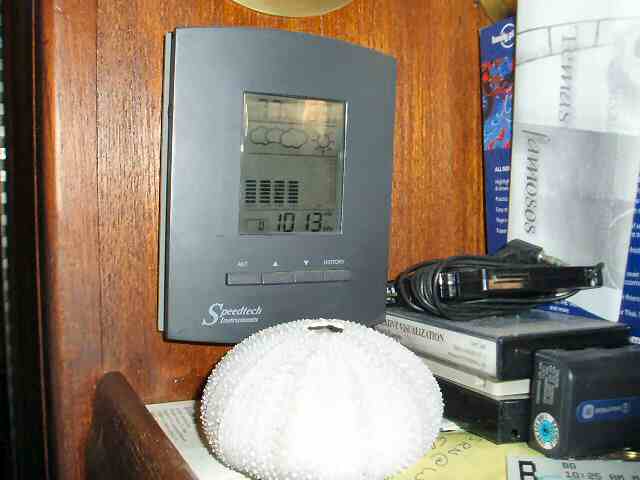Hi all,
This is our 2-year gear report. Yes, we have been
out, cruising, for two years! We departed our slip (the last
permanent one we had), on September 15, 2004.
We have stayed in a slip in Marina de La Paz for a few months! With a
small boat, why not?
We will try to make this gear report short, like last years,
and like last year, just include the items aboard that we think anyone
who may be going to cruise would be interested in. We will try to take
it from bow to stern. If you read this and have any questions, just
send us an email and I will try to get back to you.
First
and foremost,
Guenevere
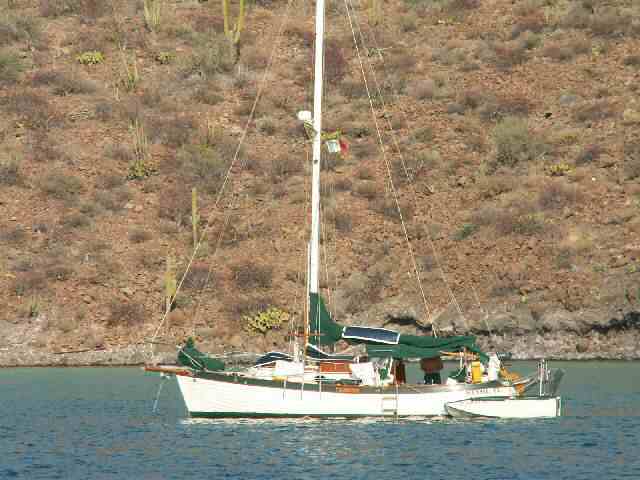
What I said last year was, "She has done us proud in
EVERY respect! We have not come in to one port that we did not get
Ohhhsssss and ahhhhhssss! And she has taken all the punishment that
day-to-day life at sea has dished out to her. She is a very fine and
meticulously put together, high quality boat capable of far more than
we can take! She has really taken good care of us!" AND it still holds
true today! If anything, I am happier now than last year, if that can
be?
The anchor
windlass.
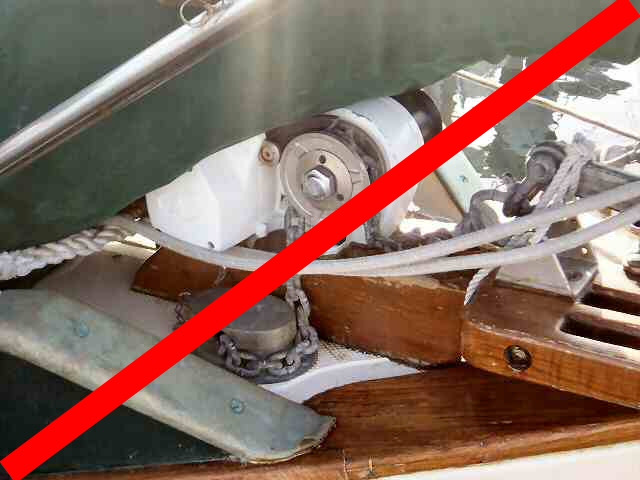
We HAD a Sampson Lowrance 600 GD electric.
Shortly after we did last years
report, the windlass STOPPED
pulling the anchor up. Last time I checked, that was the only reason
for a windlass.
The symptoms were that the
anchor would fall just fine, but
would not come up. Also, the circuit breaker would NOT pop. That is,
the windlass was not overloaded.
I wound up troubleshooting by
opening the anchor
locker, cutting the power leads and going directly to a small
motorcycle type
battery. It still did not work.
I called the support line and
the first thing the guy said
was that I must have overstressed it. NOT ONCE did I leave the anchor
set
without the manual stop set. I NEVER allowed the boat to ride to the
anchor
just on the windlass!
As it turned out, inside the
unit is a roller bearing that
only spins one direction. I did not know they made such a
thing! That bearing
had gone bad. The design is that this is what stops the anchor from
falling
until the switch is made. In my opinion, this is very poor
engineering!
I once again called, and you
cannot purchase just that bearing.
Naturally, you have to get the kit with ALL of the unit’s
bearings. And oh, by
the way, that bearing MUST be pressed in and out. And, it MUST be
pressed in
the correct way!
The outcome is, we were trying
to go out and it was faster,
better and cheaper to just replace the windlass! So, that is what we
did. We
now have a Lewmar Pro-Series H700.
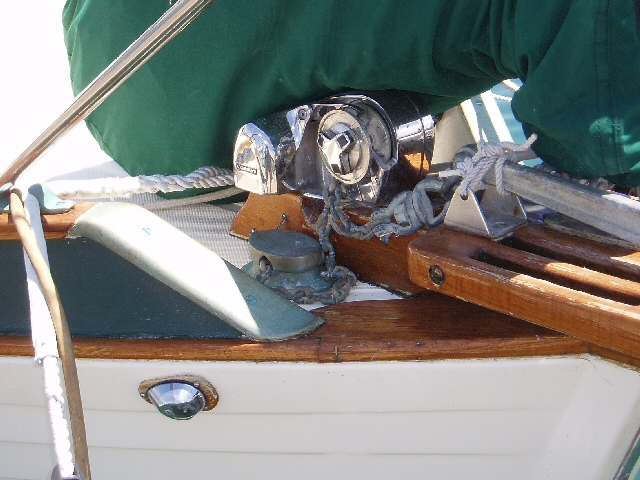
When I talked to Sampson
Lowrance, I was told that they no
longer sell windlass. I said I was happy that Lewmar bought them out. I
was
informed that it was the other way around and that the Lewmar name was
kept
because it was better thought of!
We have been using the new windlass now since March of this
year so I cannot give you any details yet. BUT, It
is my feeling that a lot of the makers of marine
equipment (NOT just Sampson Lowerance and Lewmar) feel that if they are
designing items for boats under 50 or 60 feet,
they only need to design for weekend users. I expect that the Lowrance windlass
would have worked for a long time under only weekend use. This is
something to consider if you are planning to head out in a smaller boat.
Deck box / Wash
down pump/speakers/dashboard
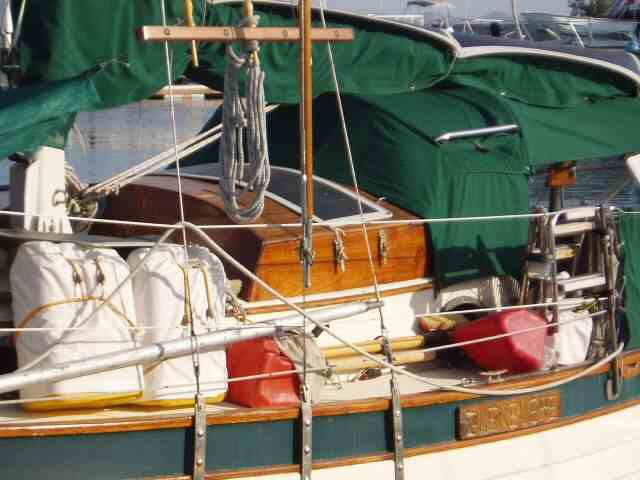
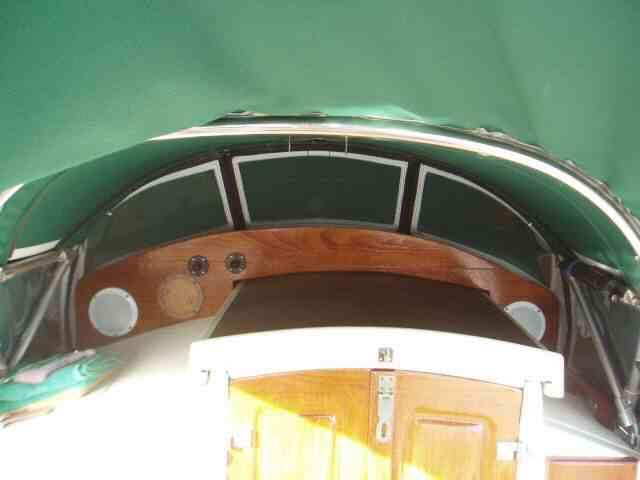
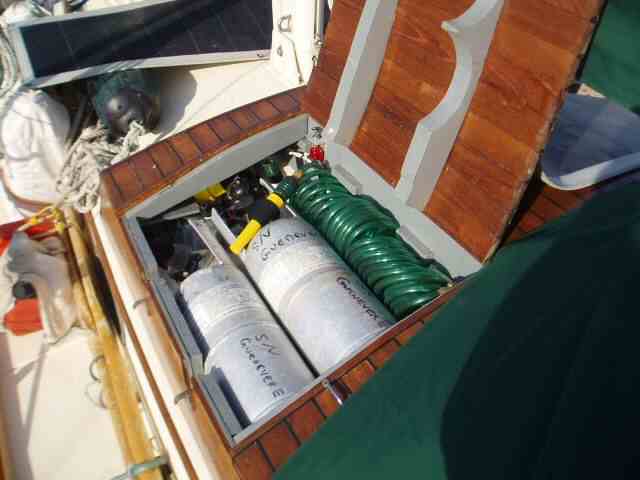
Just as last year, it is standing up well to all the
stuff we have put in and on it. No problems at all. It is NICE to have
the deck wash down pump up there and I use it a LOT when cleaning the
seafood in the cockpit. The speakers work GREAT for evening cockpit
sundowners. And they also work wonderful for movie watching. We put the
computer on a sink board on the partially closed main hatch top, pop a
DVD into it and run an audio wire from it to the radio and we have our
very own outdoor theater!
Raymarine Tridata
depth/speed
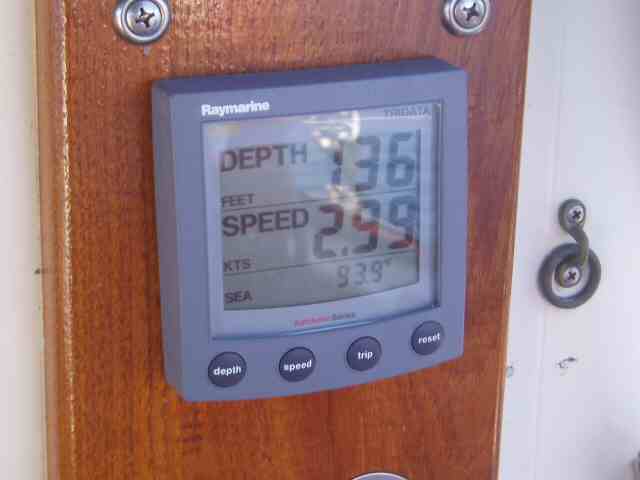
Last year I said - "What can I say, This was $$ down the tubes. As far
as the speed indicator goes, it never did a good job. We installed it
just as we were about to head out. I ran the measured mile on the
Oakland estuary 4 times (as called for in the instructions) to
calibrate the unit. By the time we got to Half Moon Bay I was unsure of
it and was positive it was no longer accurate by the time we got to
Monterey Bay. Even after adjusting for currents. Off of Santa Barbara,
it just quit reading any movement. I keep taking it out and cleaning
it, but it's not worth the effort. I now stick to the GPS for speed."
We
still have this on board, only because I am to lazy to remove it and
fashion a new board. And, we do still use the depth sounder. When I can,
my plan is to remove it and put in 2 depth sounders (different
frequencies). That way, if one quits, we will have a backup. A couple
of times I have wished for two depth sounders.
Standard Horizon
Chart plotter/GPS (model GPS Chart 150C)
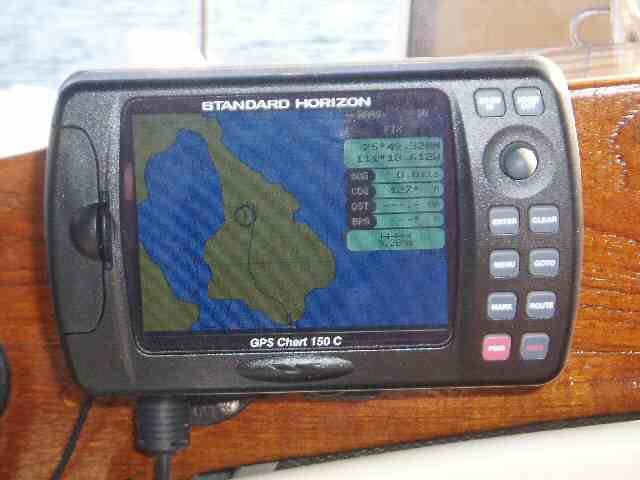
It is STILL working so good it makes me lazy. We
still
have it "on" anytime the boat is going to move. I am using it to plan
the next one or two legs of any and all trips, to compute the distance,
time and fuel. We are also using it as our official trip distance log
(see Tridata info above). The one thing that you need to watch for is
that the C-MAP charts you use in it are made from the official U.S.
paper charts. SO, At times here in the Sea of Cortez and on Cedros
Island, it shows us well aground! I checked here a few days ago and the
charts may be off by as much as 0.87 miles. At first I thought it was a
problem with the C-MAP chart. Then we helped in a "MAY DAY" rescue that
was coordinated with a HAM net, the U.S. Coast Guard and the Mexican
Navy. I came to find out that the U.S. charts are way off! The Coast
Guard and the Mexican Navy coordinate to find the real position when
needed. So, we mostly use it to get us close, then go to good old "eye
ball" navigation. During the last two years I have talked to
a
number of other cruisers here in the Sea of Cortez, and they are ALL
having the same problems from ALL of the systems in use.
JRC Radar

This year we have only turned it on for about 2
hours.
And that was just to make sure it was still working. It is normally so
clear here that it's not required. I did use it during a storm just to
make sure our anchor was not dragging. I could keep a watch on our
distance to shore.
Yeoman Chart
plotter with GPS
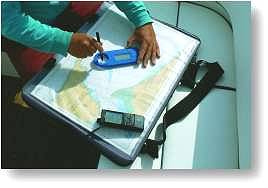
This did us GREAT service down the coast and gave us
a
very good since of security by having all of our hourly positions
plotted on a good old paper chart. Since we have been in the Sea of
Cortez, and our trips have all been during the day and in clear
weather, within sight of land, we have not used it this year. But we
like it enough that is still has a place aboard!
Autohelm 1000
autopilot

This year it has worked very well with no problems
at
all. We only use it when the engine is running so we do not worry
about the power it uses.
Monitor wind vane
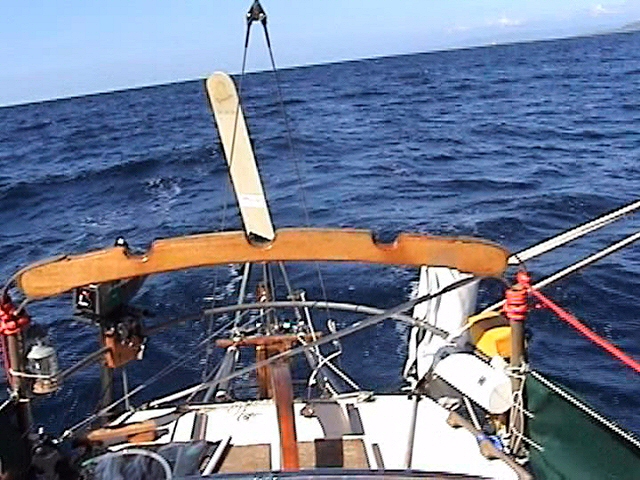
This year, STILL can't live without it!
Unisolar flexible
solar panels (4 each)

Last year I said that each panel is rated at 1.94 Amp. They work well
and are easy to put out once we reach anchor. They roll up nicely and
stow in the aft cabin when not in use. If it were not for the freezer,
they would be way more then enough to power the boat all the time. BUT,
when I get the chance, I am going to get more solar panels. Here in the
Sea we do not get enough wind to make a wind generator useful. My plan
is to get panels with sufficient output to run the water maker
during the sunniest two hours of the day. That should more than cover
all of our needs. I plan to make it so that I can add, or remove panels
as required. They also store quickly for bad weather
preparation.
That STILL holds true! I ordered 5 solar panels last October, from
three sources. I informed them that I needed the panels before 15
January 2006 as I was driving back to Mexico and needed to bring them
with me. NOT ONE source came through! However, I did contact a new
source and now have the panels I wanted.
PLEASE read my commentary at the
end of this report regarding power and water.
Sun Covers
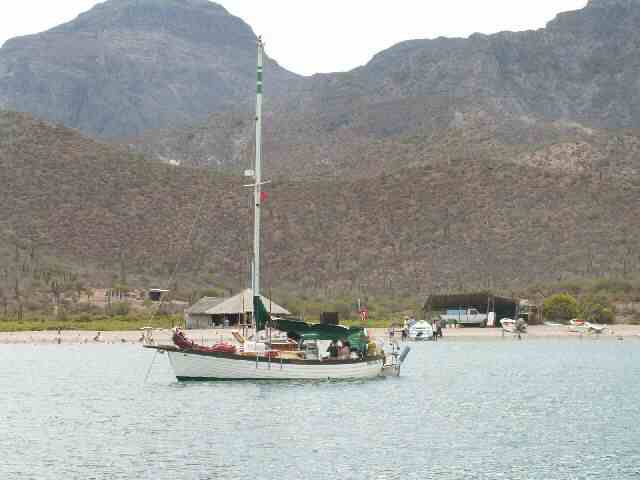
Here in the Sea of Cortez they ARE A MUST! You can
NOT live without them. We had our canvas guy make us a cover that goes
from our dodger to the boom gallows and can stay on when we are
sailing. WE LOVE IT.
We now have a ShadeTree sun cover. It goes up easy, as far as covers
go. It is strong and we are able to "reef" it easily at night. We reef
it every night in case of a Chabasco (sudden storm). It cools the boat
off by at least 5 degrees! At least it feels that way. During this
summer, the inside temp of Guenevere never got above 97 Degrees F. We
visited other boats that had a cabin temp as high as 107 Degrees F.
Porta-Bote dink
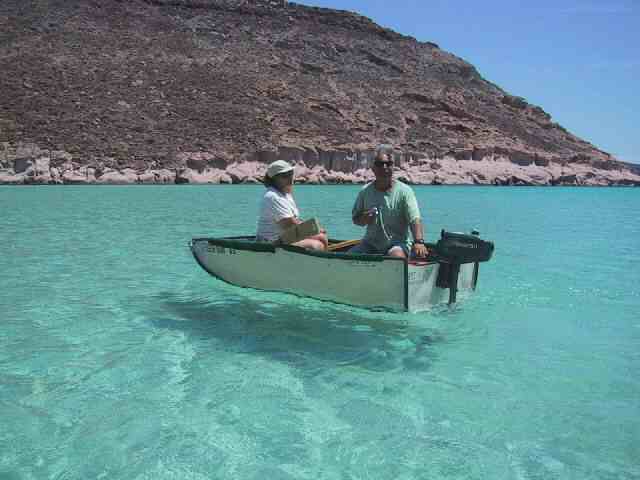
Our 8 foot
Porta-Bote
is still working good after 12
years! We bought a set of the new plastic seats in 2003. They are a LOT
lighter than the old wood ones and we were very happy with them. BUT,
after only one year,
due to the heat, the plastic seats are breaking. The middle support
that keeps
the boat bottom ridged, and is hinged in the center bottom of the seat
has pushed it's
way up into the foam center of the seat. This slows the dink down when
motoring as the bottom does not stay as ridged as it should. I tried to
fix them when we were back at a dock. It did not work well.
Here is what the OLD seat bottom supports look like.
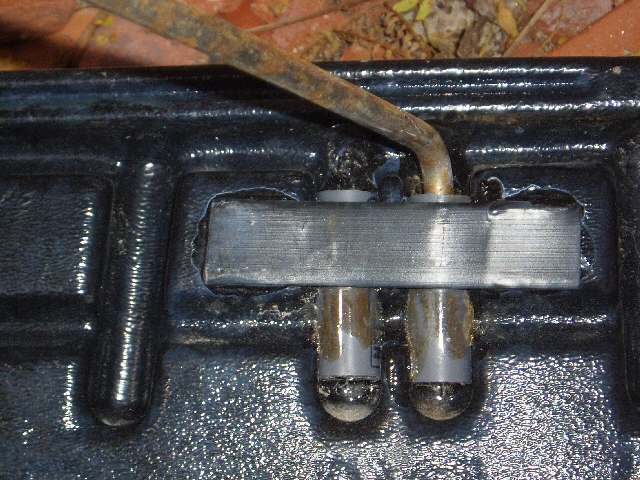
This shows how the metal seat/bottom support hinges on the underside of the seat. This is a good, unbroken support.
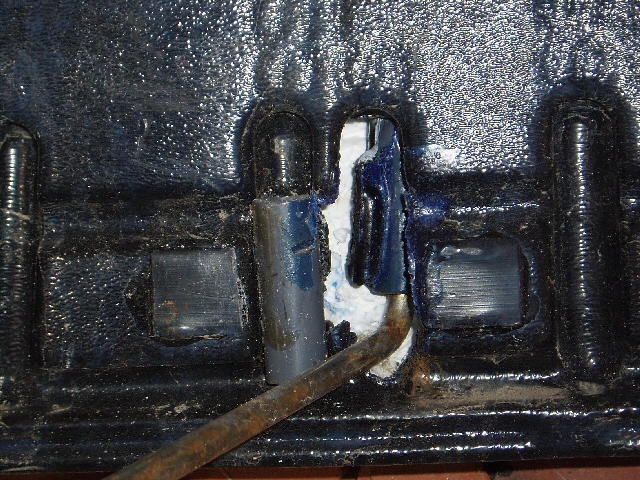
This photo shows the failure mode. You can see how the metal support
has broken through the bottom of the seat and is working it's way
through the white Styrofoam. Once the Styrofoam breaks away, the
seat can drop about 1.5 inches and the bottom is no longer ridged..
I do NOT have any photos of the new support system yet. When I can, I will post them.
At one
anchorage we visited, there were 5 boats, all with
Porta-Bote dinks! AND, we all
had the same problem with the seats. When we got back to La Paz, I
managed to call the
Porta-Bote company. I was informed that they had redesigned
the support. They were very willing to supply a new set of supports
that could be retrofit to the old seats. I was informed that they
wanted happy users! I do not have the parts in hand yet. But will
report back.
We have now talked to a lot of boats using
Porta-Bote for every day
dinks. When used like this, they get a LOT of usage. We have to say
that we think they are a great dink for use in the Sea of Cortez. The
beaches here can be smooth sand or rocky. It's nice to not have to
worry about just running it up on the beach. When other boaters stop
off the beach and wade in, we can just run up and step off.
We have heard that some people have had problems on the mainland,
trying to get to the beach through any sizable surf. We know of at
least one that was upturned heading through the surf. But then, we have
also heard of a number of inflatables doing the same. We have also
heard from other
Porta-Bote owners that had no problems going
through surf. We do notice that the bow of the
Porta-Bote tends to be a
bit low and can scoop water if it drops.
Other than that, I get about 8 Knots of speed out of the 3.5 HP motor
when it's on its' plane.
TOHATSU Outboard motor
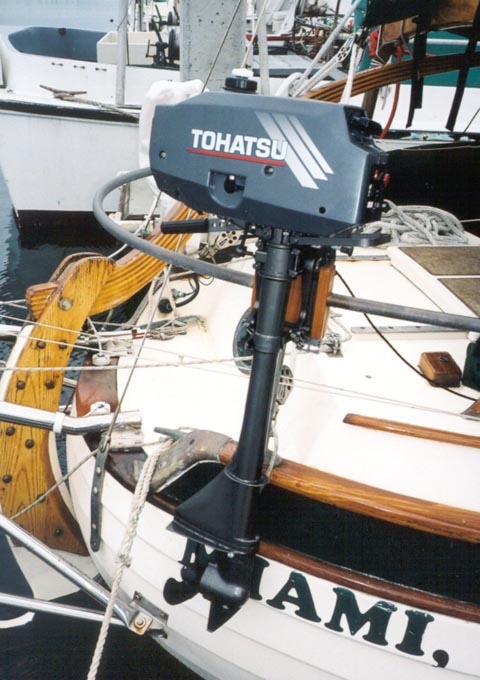
We have been using a small 3.5 horse
power, two stroke, Tohatsu outboard motor. We decided to go with this
motor for a number of reasons. The first was, it is light weight. I can
pick it up with one hand. That means not a lot of stress on the aft
rail. The second was because it is a two cycle, I can empty out the
fuel, roll it in a tarp, and store it out of the elements for an
offshore passage. You can not do that with a 4 cycle engine. And the
third is that it is simple to work on! Most anyplace in the world,
you can get a two cycle engine fixed, no so for a 4 cycle. It will put
our PortaBoat on a plane if just one of us are in it. It will not plane
with both of us or any big load.
The down side, it's not nearly as fast as a bigger motor. But
then, we are cruising and at times must remind our selfs that speed is
not all that vital. But it might be fun Grin...
LED Spreader lights

We
changed out the
normal spreader bulbs for these LED cluster lights. They each have 36
LEDs in them. There is more then enough light to use on the decks!
Before I put them in, I used the Link 10 to measure the amount of power
the old lights used. The old bulbs (2 each) used 3.3 Ah. These new LED
clusters
use 0.3 Ah! We used them often in the sea. I got them from
Superbright (http://www.superbrightleds.com/) at a very reasonable cost.
INSIDE THE BOAT
Two Hella cabin
fans (one over each berth)

Without these, we could NOT have spent the summer here in the Sea of
Cortez! For the past month, they have run mostly 24/7 when we are on
the boat! Both fans have now had some problems. On one, the fan blade
has come loose. I replaced it with a blade from another fan we had
aboard and it's still working, but the safety cover will not fit back
on. The other has been slow to spin up and at times makes a screaming
sound. I think they had done GREAT duty for the amount we asked of
them. Our plan is to purchase two more just like them and also a couple
of "clamp-on" to use around the boat. In the Sea of Cortez, during the
summer, you can not have to many fans!
Icom 706 Mk IIG
& Yeasu external speaker
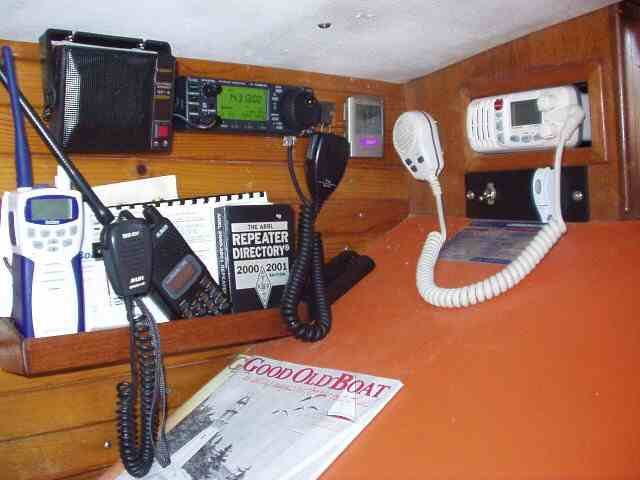
The Icom is a life saver! We use it EVERY day. The
net's provide great info on everything from weather to where other
boats we know are to what the next anchorage is like. The external
Yeasu speaker was a waste of $. Not worth it and we no longer use it at
all. On a visit to another boat, we saw an SGC ADSP2 external
speaker. This speaker has a number of filters built in to it to make
hearing a voice much better. On the other boat I could hear the
difference! So, I have ordered one and will let you know on the next
report how it is working.
Pactor Modem
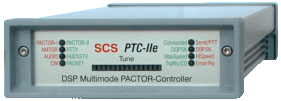
WOW! This is magic! It has been working
well and we are getting and sending email almost every day! We get
speeds of around 1400 to 3600 Baud. We have the Pactor 600 with the
Pactor III software upgrade. Unless you are running 2 separate radios,
you do NOT need the Pactor Pro! (write me if you have questions) We are
using it with an Averatec 3150 computer. The computer does not use a
lot of power and will also play our DVDs. I have this set up so I plug
1 (one) USB cable into our computer and it controls the radio tuning
AND the modem. This year I had one problem and it may have been from
heat buildup or a loose/corroded connection. I shut everything down and
removed and replaced all connections and have not had the problem
since.
Norcold Freezer
(Built in)
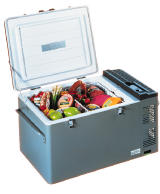
It is working good, BUT, it sure does use
the power. In the US, it was running about 50% of the time to keep
itself at the temp we set. We
could keep ice cream hard! Down here in the heat, we decided that cold
drinks were more important than keeping things frozen, so now we are
asking it to keep a temp of about 36 to 39 degrees F, and at the same
time cycling in and out from 4 to 8 quarts of water. Keep in mind that
the water is about 90 to 98 degrees when we put it in. So, you can see
why it's using more power than I thought it was going to use.
PLEASE read my commentary at the
end of this report regarding power and water.
Force 10 Galley
range (European 2 burner model with oven) and Trident gas controller with alarm.

We got the pazieo starter battery holder fixed (it
was shorting itself out). It's been working great. Jill has made some
GREAT bread and
other tasty treats in the oven and the top has been a
workhorse. We have found the Trident gas warning to be a
pain! It is very SENSITIVE! We cannot use spray Pam (or any other
aerosol spray) inside the boat without it shutting down the gas and
ringing the alarm! But, we feel it is worth the effort to keep
it. We have been told by other boaters that it eventually
becomes less sensitive to extraneous things. This year we are getting
fewer alarms than last year.
Battery compartment
(at bottom of companion way ladder, with 2 additional Group 31
batteries)
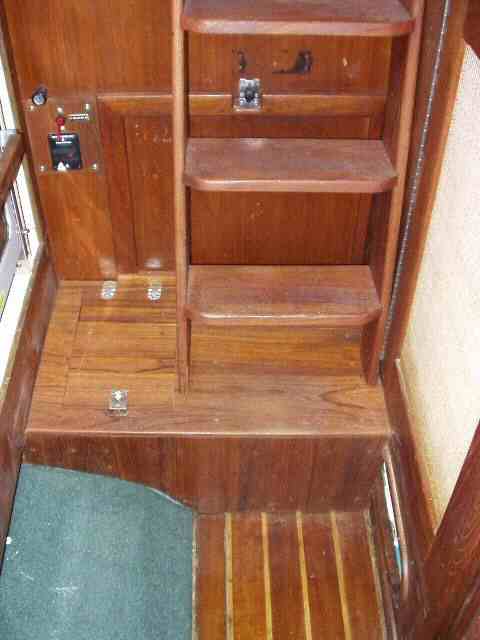
If we had not added the extra batteries, and still
had the Norcold, we would have had to run the engine every day for at
least an hour! For
us, 3 batteries of at least 100 Amp hours each is a minimum! All of our
batteries are Group 31 AGM type, and so far, we are very happy with them. We
never let them get below 50 % discharged (50% DOD). So I expect them to
last. It sure is nice to not have to service battery water in our SMALL
engine compartment!
We decided on AGM because our plans were for long distance off shore
cruising in remote areas. I know we can get wet cells almost anyplace
in the world. That may not be the case with gel. If we have one battery
go bad, in a pinch, we can stuff in a wet cell with no problems as the
AGM and wet cells take the same charging voltage. NOT SO with gel
batteries.
New Yanmar 2GM20F
engine

Once we fixed the problem of water back flowing into
the exhaust system by adding a Vitus valve. It seems to be working
well. I check the
alignment often and all is doing well now.
DriveSaver
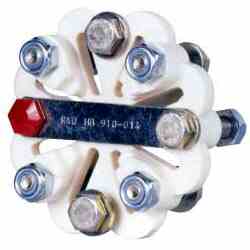
This is a great piece of gear. I picked it up at a
boat show just in case I had a problem with the Yanmar flex coupling.
During the engine repair, I installed it. It has a GREAT feature that
allows you to do a shaft alignment without decoupling the drive train!
This saves a LOT of time and energy. It also allows me to check
alignment often so I have a heads up if ANYTHING is moving about. I did
have an engine mount bolt loosen up during a passage last year. We
swung in, dropped anchor in a nice spot, and had the bolt tight and an
alignment done in about an hour or so of work! During our trip to the
USA early this year, I bought a spare!
Balmar high output
alternator
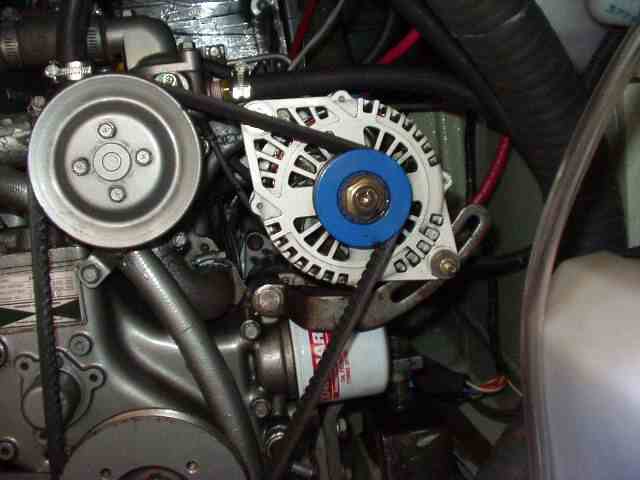
Works GREAT, but have had to take off the temp
sensors from the battery and alternator. The manufacturer sent me a new
alternator temp sensor for free, but even with the new one, due to the
high ambient temp (I think) it was cutting the power way
back. Great customer service. The same thing happened this
year. I had to disconnect the temp sensors so I could charge the
batteries. I have added a small inside/outside temp sensor in the
engine compartment to let me know how hot I am running. During the
summer, I need to run with the forward engine door off, and the aft
cabin door opened to vent. AND, I run a fan to force air through the
compartment. I think Balmar said it is designed to cut back at 225
Degrees F. When the outside temp is over 100 and the sea water is over
95, the temp in the engine room jumps up very quick.
Little Wonder 250
water maker.

With the amount of water we have in the two tanks
(40 Gal total) we LOVE this magic device! It gives us a big boat feel.
We take freshwater showers, wash our clothes in fresh water and wash
dishes in fresh water and do not worry about running out of drinking
water. In this heat, we are going through 4 to 8 quarts of fresh water
per day for just drinking! It is mounted in the port aft cabin
berth.
PLEASE read my commentary at the
end of this report regarding power and water.
Newcon Gen 1 night
scope.
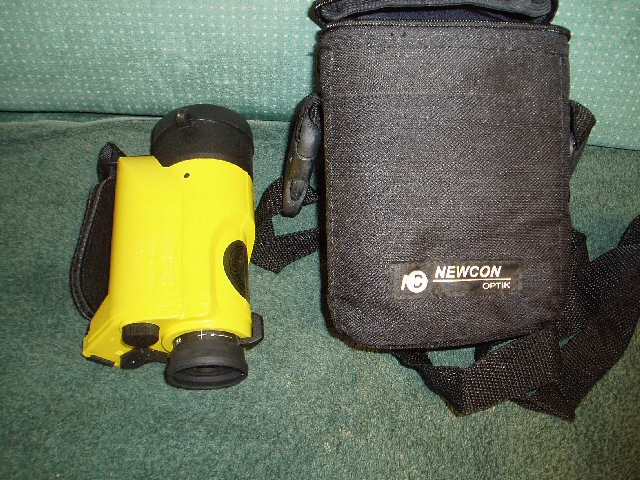
Don't waste your $. Just no use, at all.
Link-10 energy
monitor
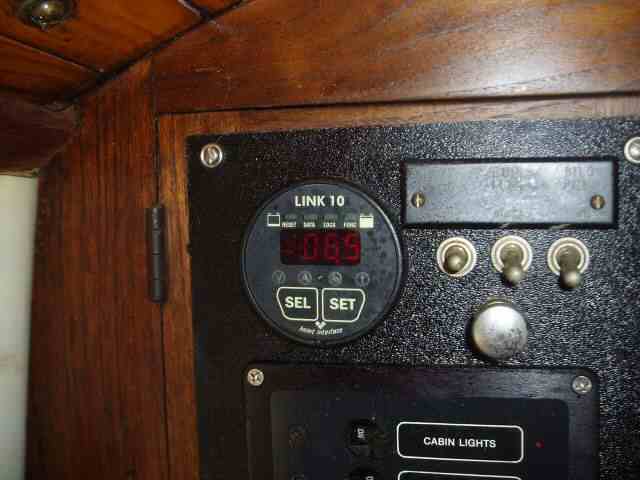
This is one of the GREAT magic items we put on board! Before we got
this, I would go behind Jill and turn off the lights to conserve power.
I never knew exactly how much we had, or had left. I was driving Jill
crazy. NOW, all I have to do it take a look at it and we know our
status! The BIG bonus is that you can make sure you do not
over use your batteries! That is, do not use them beyond 50% discharge.
This greatly extends there life and SAVES a LOT of $$$$$.
Coffee Press

We have tried a number of
different coffee makers. We
first tried a Melita drip pot, but were
afraid we would break the glass, and what to do when we run out of
filters. We tried a plastic coffee press from West
Marine, but the coffee was cold almost before we could drink it.
We have now found THE ANSWER!
We were given two, one cup
stainless steel, thermal mug, coffee presses and a small stainless
steel
thermal coffee press.
THEY
WORK GREAT! Finally we found a coffee maker that works
for both of us, and guests! Best of all, I get coffee like I like it
and Jill gets it as strong as she likes it, and all out of the same pot
of hot water.
They came from Star Bucks.
Tops-In-Quality
ladder

Has
been working GREAT! At first we did not think we would be using it. But
once we started to anchor out, and swim directly off of the boat, the
value was evident! We just slide it back to the cockpit and we are set.
We found that the more we use it, the easier it is to slide back and
forth.
LaVac head

Absolutely
the BEST head we have ever had aboard a boat! The seals on the lids
keep all the bad smells at 0! As long as it's mounted per the
directions, it almost pumps dry. We have set it up so that the same
pump will work for the head AND the holding tank (for offshore work),
and a deck pumpout. This year one of the seals has started to tear. But
it is STILL working GREAT, even with the broken seal. We have a spares
kit and I will order a new seal as soon as I get the chance.
CDI Feathering prop
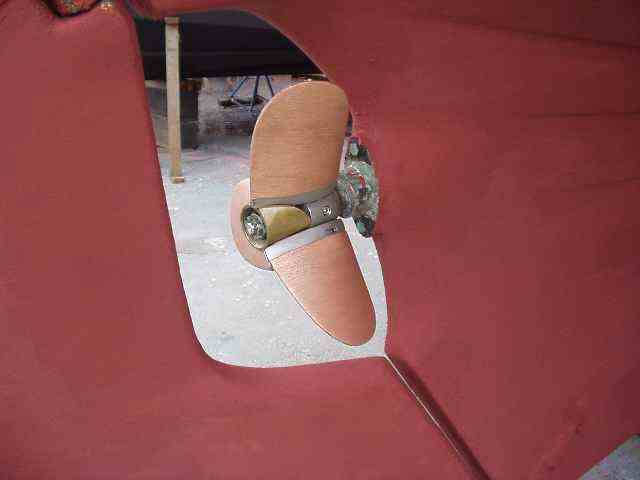
It seems to be working very well. I coated the blades with the same
CopperPoxy bottom paint (as you can see here) and it's holding up very
well! We will keep you informed if we have any problems. During the
next haul out, I may increase the pitch by 1/2 inch or so.
In late September and early October, 1996, we sanded ALL of the old bottom paint from
Guenevere. On 6 and 7 October, 1996, we coated the bottom as directed in the
instructions that were provided with the CopperPoxy.
It's official, the CopperPoxy bottom has stopped working. I am now
finding hard growth all over the bottom. When we bought it, the product
said it would last about 10 years. I guess they had it correct.
During the last month or so in
the Sea I needed to clean the bottom about once every other week. It
may be the water, another boat with a fresh bottom (3 months old) was
also having hard growth.
This year, the RAM mic crapped out! I had a problem with
troubleshooting it down to the radio, the mic, or the cable. So when
we were in the US, we bought an identical replacement for all the
parts. It turns out it was the RAM mike itself. I am unhappy with that.
I think it should have lasted more than one year! The cord also
darkened up over the year. It says it is for use in the cockpit, but
once again, I think it is aimed at weekend use only! I am not sure what
I would use if I changed, it's very nice to have the full ships radio
in the cockpit! All summer we were talking to other boats trying to use
handhelds in the cockpit and they were ALL having problems! Batteries
dying and low power output makes relaying on a handheld less than
optimum.
We put the information that
follows together during our most
recent few months in the Sea of Cortez. Please note that IT IS HOT in
the Sea of Cortez
and that what follows is our thought only.
Asking a manufacturer what the
output of his unit is only
gives you a number to compare units. DO NOT think that you will
actually get
the amount stated in the advertising. The actual
“usable” amount of water
(product) you get from a unit depends on a lot of different factors!
First, the temperature of the
intake water makes a big
difference. Hotter (up to a point), gets more product water, cooler
gets less.
The salinity (amount of salt)
in the water makes a
difference. More salt, less product.
How long after startup does it
take to start getting good
product water? 5 min or more?
How often do you need to back
flush the unit, how much water
is required? If the unit needs to be back flushed every time it is
used, and it
takes 2 gallons, you need to subtract 2 gallons from the total product
water
made, EACH TIME!
How often do you
“NEED” to run the unit? Some units MUST be
run at least once every 3 or 4 days. If not run, you need to back flush
it, or
preserve (pickle) it.
Over time, the unit will start
to produce less product water
due to normal usage of the filter element.
One other thing you need to
think about is if you plan to
just let the water maker run without you being present. I
don’t think that is a
good idea, but some people do. When we make water, it goes into a
separate tank
and I sample it (taste test) BEFORE it goes into our main tanks.
Having said all of the above,
we seem to be getting about
70% to 75% of the “rated” product output.
How much water do you need to
make? For us, that amount is
about 28 gallons every 4 days. That is, we need per person, 1 gallon to
drink,
½ gallon for cooking, and 2 gallons for washing. That is 7
gallons per day and
we try to make water every 3 to 4 days.
In the heat of the Sea of
Cortez, 1 gallon a day to drink is
the minimum! And washing off after a day of swimming may not be
critical every
day, but after a few days, YOU NEED IT! This year, there was a drought
on the
Baja and a lot of the animals were dying due to lack of water. So water
was hard
to come by. We felt that a water maker was a necessity.
Of the other boats we met and
talked to, only one had a
working “parts per million tester”. A lot of boats
bought them, but all now
just taste the water. We did not talk to any boat that was satisfied
with a low
output water maker. It is AMAZING to watch the fresh water flow out of
the product water hose. You look at it and ask yourself, "is that all
it's making? is it working correctly?" This does not apply to emergency
units!
Make sure you have it working
BEFORE you depart on your cruise! Getting it worked on once you are
away from your home waters is HARD TO DO!
Now on to how much does it
cost? Not to purchase, but how
much power does it take to operate.
By now, you know all of the
systems we have aboard
Guenevere. So you know we need a bit of power.
The first year we were in the
Sea of Cortez, we had 4 each
32-Watt Unisolar flexible Solar panels. During the heat of September,
this was
WAY LOW! We had to start the engine every day or two.
The major draw of power is the
refrigerator. It draws 4 Amps
per hour of usage. We have super insulation, and if we did not open the
box,
the solar panels worked just fine. But, the real draw was the 2 gallons
a day
(or more) of water that we cycled into and out of the unit.
During a number of talks with
other cruiser at beach
bonfires, most boats were down by 50 to 70 Amps each morning. We were
right in
there with the others, just a bit higher than the lower numbers.
You may think that this is not
a problem, but let me tell
you how unhappy you can get sitting in the boat running the HOT engine
on a
VERY HOT day! It was also getting so hot that the temp sensors on the
alternator and battery would lower, or cut off, the alternator output!
That
would require us to shut down, wait a few hours and start over! A BIG
PAIN!! Not even talking about how BAD it is to use your main engine to
just charge the batteries!!!!!
During the summer here in the
sea, we have almost no wind a
LOT of the time. Not one cruiser we talked to was happy with their wind
generator.
We talked to about 6 or 8 boats about their units.
We have come up with the figure
we think we will put on
board. See if this helps you.
We know that our water maker
uses about 14 to 18 Amps to
run. Our refrigerator uses 4 Amps. So we plan to have about 20 to 25
Amps in
solar panel generation capability. That will be 1 each 85-Watt panel on
the
stern rail aft of the back stay and forward of the Monitor wind vane. The current 4 Unisolar
panels. Plus 4 more
ridged panels mounted (removable) from our pin rails. This will allow
us to add
and remove panels as required.
The logic is that at anchor,
once every 3 or 4 days, we can
fly all panels and during the four sunniest hours, make water, run the
refrigerator
and still be able to trickle charge the batteries. On the other days,
we should
be able to charge the batteries full by noon. Also, on an overcast day,
we
should still be able to fully charge the batteries.


































